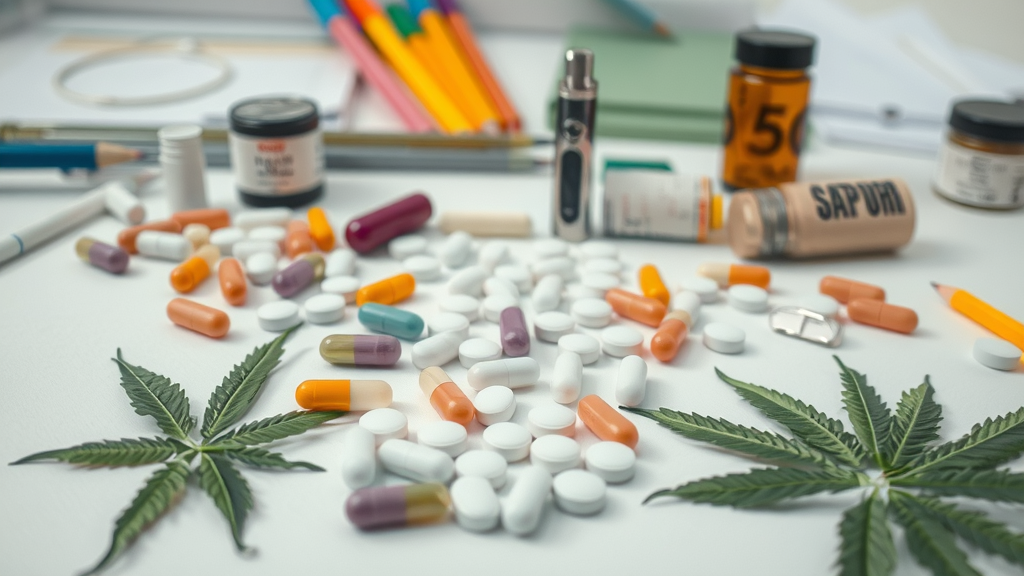Startling fact: According to the most recent Monitoring the Future survey, nearly 36% of high school seniors reported using an illicit drug in the past year. This isn’t just a statistic—it's a wake-up call for parents, educators, and communities everywhere, signaling urgent trends in teen drug abuse statistics that can’t be ignored.
"Every year, tens of thousands of teens try drugs for the first time—a number that continues to shock parents, policy makers, and communities across the nation."
What You'll Learn About Teen Drug Abuse Statistics
Key trends in teen drug abuse statistics
Demographic differences among youth drug abuse patterns
Mental health and its connection to substance abuse
The impact of illicit drug use and overdose deaths on young adults
Current approaches and solutions to address teen drug abuse

Striking Facts: Opening the Conversation on Teen Drug Abuse Statistics
Recent surveys on teen drug use
Surprising increases and declines revealed by statistics
Comparing current numbers with previous decades
Teen drug abuse statistics have evolved drastically over the past few years. The Monitoring the Future survey and the National Institute on Drug Abuse both report that while certain illicit drug use—such as marijuana—remains high among young people, there have also been notable declines in some substance use behaviors compared to previous decades. For instance, alcohol and cigarette usage among students in eighth and tenth grades have steadily dropped since the early 2000s, but the growing misuse of prescription drugs and the rise in vaping present new challenges. Current data show that about 1 in 4 high school students have engaged in some form of substance abuse in the past year.

"Teen drug abuse statistics aren’t just numbers—they represent real young adults whose lives are affected every day."
Understanding Teen Drug Abuse Statistics in Young Adults: Trends and Insights
Age group breakdowns of drug abuse
Patterns of initiation into illicit drugs
Longitudinal analysis and what the numbers predict
Breaking down teen drug abuse statistics by age group offers invaluable insights into how and when substance abuse behaviors begin. Most data show that initiation often occurs between ages 12 and 17, with a sharp increase just before and during high school. According to the National Institute on Drug Abuse, approximately 16% of students in eighth grade report trying at least one illicit drug in their lifetime. This number rises steadily with each school year, peaking around senior year when nearly 37% admit to using illicit substances. The longitudinal analysis from the Monitoring the Future survey indicates some progress, as certain drugs see decreased prevalence due to ongoing prevention efforts. However, new threats, like synthetic drugs and prescription medication misuse, continue to shape teen drug abuse statistics for young adults.
Explaining Teen Drug Abuse Statistics: Visual Guide for Parents & Educators
Factors Driving Teen Drug Abuse Statistics Among Young Adults
Social and peer pressure influences
Access to prescription drugs and illegal substances
Mental health and substance abuse links
Family and environmental contributors
Teen drug abuse statistics are shaped by a complex web of influences. Social pressure and the desire to fit in remain leading contributors, with many young people citing peer encouragement as a catalyst for experimentation. Easy access to prescription drugs—whether in the family medicine cabinet or via friends—also propels misuse, especially as these substances can seem "less risky" than street drugs. Environmental factors, like unstable home environments or parental substance use patterns, further increase risk. Importantly, a growing body of research links mental health challenges such as depression and anxiety with higher rates of drug abuse, suggesting that for some young adults, substances become a form of self-medication. By acknowledging and addressing these root causes, prevention and intervention programs can be more effective at altering the tide of teen drug abuse statistics.

The Interplay Between Teen Drug Abuse Statistics and Mental Health
Correlation between anxiety, depression, and drug abuse in teens
Resources for identifying mental health red flags
Rehabilitation and therapy options for dual diagnoses
The intersection of mental health and teen drug abuse cannot be overstated. Several studies and national surveys have established a clear link: teens who experience chronic stress, depression, or anxiety are more likely to develop substance use disorder and abuse illicit drugs or prescription medication. These findings are mirrored in treatment programs for young adults, where dual diagnoses—those with both mental health complexities and substance abuse issues—are increasingly common. Schools, parents, and healthcare providers must be vigilant for behavioral red flags like sudden withdrawal, academic decline, and drastic mood swings. Early intervention can connect young people to therapy and drug rehab, increasing the chances of recovery and breaking the cycle observed in teen drug abuse statistics.

National Trends: Teen Drug Abuse Statistics by Age Group, Substance, and Overdose Deaths |
|||
Age Group |
Illicit Drug Use (% past year) |
Prescription Drug Misuse (% past year) |
Overdose Deaths (per 100,000) |
|---|---|---|---|
8th Graders (13-14 yrs) |
15.7 |
3.5 |
1.1 |
10th Graders (15-16 yrs) |
27.2 |
6.1 |
2.3 |
12th Graders (17-18 yrs) |
36.2 |
7.5 |
3.8 |
Types of Substances in Teen Drug Abuse Statistics: Illicit Drugs, Prescription Drugs, & More
Most commonly abused drugs among youth
Rise of prescription drug misuse
Illicit drug trends: marijuana, opioids, and synthetic drugs
The impact of vaping on teen substance abuse statistics
A closer look at what young adults are using most helps decode current teen drug abuse statistics. Marijuana remains the most commonly reported illicit substance, with nearly 30% of high school seniors admitting use in the past year. However, the danger doesn’t stop there: the misuse of prescription drugs—especially opioid painkillers and ADHD medications—has risen alarmingly, contributing to both increased addiction and overdose death rates among teens. Meanwhile, vaping devices have made it easier for youth to experiment with nicotine, cannabis oils, and even synthetic substances, often under the radar. The rapid evolution of illicit drug trends demands continual data monitoring and education for all involved in adolescent health.

Expert Interview: How Prescription Drug Abuse Shapes Teen Drug Abuse Statistics
Overdose Deaths in Teen Drug Abuse Statistics: A Growing Concern
Recent rises in overdose death statistics for teens
Illicit drugs and fatal outcomes
Prevention strategies in schools and families
Perhaps the most chilling aspect of current teen drug abuse statistics is the marked upward trend in overdose deaths among young adults. Synthetic opioids such as fentanyl, often unknowingly mixed into pills and powders, are a leading cause of fatal outcomes. Data from the Centers for Disease Control and Prevention show that the overdose death rate among teens has nearly doubled in the last five years. Prevention strategies are urgently needed: school curricula now include overdose awareness, students are trained to identify a crisis, and families are encouraged to keep naloxone at home as a safety net. Open conversations, early detection of risk factors, and destigmatized access to treatment programs are crucial to changing the narrative reflected in these sobering numbers.

"Today’s teen drug abuse statistics paint a stark picture, but they also reveal crucial turning points and opportunities for change."
The Role of Drug Rehab and Recovery Programs in Teen Drug Abuse Statistics
Current rehabilitation success rates for young adults
Barriers to access for teens
Best practices in teen-focused drug rehab centers
Effective drug rehab and recovery programs can powerfully influence teen drug abuse statistics, transforming data trends one life at a time. Adolescent-focused treatment programs report increasing success—in some cases, up to 60% of participants avoid relapse after 12 months, especially when combining therapy, medication, and family involvement. However, barriers remain: stigma, cost, lack of adolescent-friendly centers, and mental health dual diagnoses often prevent young people from seeking or completing treatment. The best centers blend group therapy, peer mentorship, and holistic care, emphasizing trust and support as key to long-term recovery for young adults. By building awareness and expanding access, communities have a tangible way to improve the outlook painted by teen drug abuse statistics.

Addressing Substance Abuse for Young Adults: Solutions and Prevention
Community-based initiatives for prevention
Peer support and intervention programs
The importance of destigmatizing substance abuse recovery
Preventing teen drug abuse is as much about community engagement as it is about policy or rehab. Community-based initiatives—from after-school programs and mentoring to substance-free social events—reduce risk and foster resilience. Peer support and intervention programs, where youth help each other recognize and resist risky behaviors, have shown significant success. Destigmatizing substance abuse recovery is equally crucial; language, cultural barriers, and media portrayals must shift to encourage young adults to seek support without fear of judgment. When families, schools, and communities come together, the ripple effect can drive down negative statistics and empower young people toward healthier futures.
Top 5 Most Commonly Abused Drugs by Teens: Marijuana, nicotine (vaping), prescription stimulants (e.g., Adderall), synthetic cannabinoids, prescription opioids.
Warning Signs That May Indicate Substance Use: Sudden changes in behavior, declining grades, secretive actions, changes in friend groups, unexplained health issues.
Effective Prevention Tips for Parents and Teachers: Foster open communication, set clear expectations, educate early about substance risks, monitor behavior, and promote healthy outlets for stress and peer engagement.

People Also Ask: Teen Drug Abuse Statistics
What are the statistics of teen drug abuse?
Recent studies and surveys on rates of drug abuse among teenagers
Comparisons with young adults and historical trends
Recent data from the Monitoring the Future survey and the National Institute on Drug Abuse show that over 1 in 3 high school seniors reported using an illicit drug in the past year. While cigarette and alcohol use has declined compared to prior decades, marijuana remains the most prevalent illicit substance, and prescription drug misuse is on the rise. Compared to young adults (ages 18-25), teens initiate drug use earlier but often in lower quantities, making early intervention especially critical.
What age group abuses drugs the most?
Data on drug abuse by specific age groups
Factors contributing to higher rates in certain groups
Analyses consistently show the highest rates of drug abuse among young adults aged 18-25, but the seeds of risky behavior are often sown during the teen years. The past year’s data highlight a sharp increase in drug use beginning in middle school, peaking during late adolescence, and maintaining high rates through college-age age groups. Contributing factors include hormonal changes, peer influence, academic stress, and increased access to both legal and illegal drugs. Prevention efforts that target these underlying causes in the early teen years can help disrupt the cycle before it escalates in young adulthood.
What is the most commonly abused drug among youth?
Analysis of the most frequently reported substances in recent statistics
Possible shifts in popularity based on recent data
Marijuana is the most commonly used illicit drug among teens today, according to the latest national survey data. Reports indicate more than 20% of high school students tried marijuana in the past year. However, vaping (both with nicotine and cannabis derivatives) is rapidly growing in popularity among youth, even outpacing marijuana in some demographics. Prescription drug misuse—including opioids and stimulants—also remains a significant concern, showing subtle increases in certain age groups.
What are some statistics about drug abuse?
Additional key numbers from national surveys
International context for teen drug use and abuse rates
Globally, the United States leads in teen drug abuse statistics, but international data show similar trends in other developed countries. The rate of substance abuse among American teens is closely monitored: nearly 8% of 12th graders report vaping marijuana, and 6% misuse prescription stimulants. About 10% of teens will develop a substance use disorder before adulthood. Comparatively, Western Europe and Australia have slightly lower rates, but patterns of early experimentation remain similar worldwide.
FAQs: Teen Drug Abuse Statistics and Youth Substance Abuse
How accurate are teen drug abuse statistics?
Most statistics are gathered through large-scale, anonymous surveys like the Monitoring the Future survey. While they may underreport certain stigmatized behaviors, the data is considered reliable enough to inform public health decisions.Where can parents and educators find up-to-date statistics?
Authoritative sources include the National Institute on Drug Abuse, Centers for Disease Control and Prevention, and annual school-based surveys.What interventions have proven effective according to recent data?
Evidence-based prevention programs, early screening, open communication, and youth access to counseling or drug rehab services are among the most effective interventions documented.
Key Takeaways: Interpreting Teen Drug Abuse Statistics
Teen drug abuse statistics highlight both urgent threats and possible opportunities for prevention.
Mental health and substance abuse are deeply interconnected for today’s youth.
Efforts in drug rehab and community support can make a statistical difference.
Insightful analysis of statistics helps us prioritize resources and shape awareness programs.
Conclusion
Teen drug abuse statistics are more than just data—they are a call to action for parents, educators, community leaders, and policy makers. By staying informed and proactive, we can help reverse negative trends and support the well-being of today’s youth.
 Add Row
Add Row  Add
Add 





Write A Comment